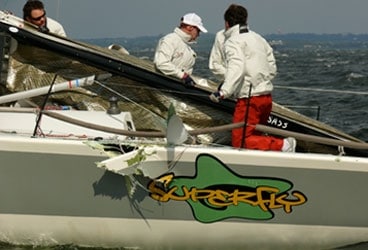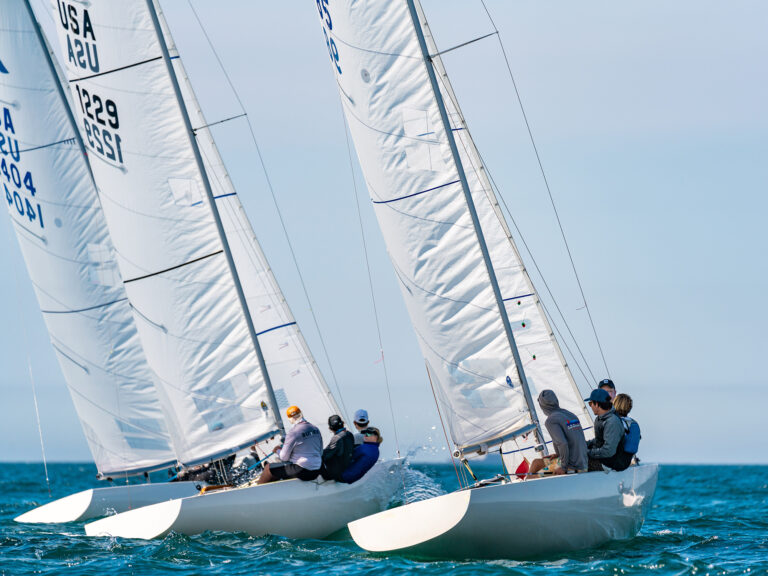
damage 368
Last month’s Rules column was the first of two columns offering advice on how to recover your financial losses if your boat is involved in an incident in the racing area that results in damage or injury. I began by strongly recommending that you protest the other boat involved, and I gave you the steps to follow to obtain a written statement from the protest or appeals committee, stating how the racing rules applied to the incident and which boat or boats broke a rule.
No rule requires a protest committee or an appeals committee to decide on “damages”-the compensation you are entitled to receive as a result of injury to a crewmember or damage to your boat. Indeed, the U.S. prescription to Rule 68 explicitly states, “No protest committee or US SAILING appeal authority shall adjudicate any claim for damages.”
The prescription goes on to say that a claim for damages “is subject to the jurisdiction of the courts.” Thankfully, very few claims for damages are decided in court. The vast majority are handled by insurance companies and, only when the amount involved is particularly large does a claim end up in the hands of an attorney or in court.
Whether you turn your claim over to your insurance company or to an attorney, the first question that will come up is this: Which set of rules, the racing rules or the government right-of-way rules, will be used to decide who is at fault? In the United States one of two virtually identical sets of government right-of-way rules apply on a given body of water. The International Regulations for Preventing Collisions at Sea apply on deep waters near the coastline, and the Inland Navigational Rules apply on inland waters. The Coast Guard publishes a book entitled “Navigation Rules” which contains both sets of rules, and in it you will find no mention of the racing rules. Therefore it would appear that the government rules always apply, even to sailboats while they are racing.
However, a 1994 landmark decision by a federal appeals court makes it clear the racing rules should apply between boats that are in or near the racing area and intend to race, are racing, or have been racing. When the racing rules apply between two competing sailboats, they replace the applicable government right-of-way rules. The court’s decision was written by Juan Torruella, Chief Judge of the United States Court of Appeals for the First Circuit, and also a former Finn sailor and currently an ISAF-certified International Judge.
The case arose because of a collision between the 120-foot restored J Class boat Endeavour and the 72-foot yacht Juno racing on the Mediterranean. The Juno established an overlap from clear astern and at least 60 feet to leeward of Endeavour. Both boats were sailing off the wind, each on her proper course, and Juno was sailing a slightly higher course than Endeavour. Neither boat changed course, and Endeavour’s boom collided with Juno’s rigging, resulting in serious damage.
The suit for damages was heard in the U.S. court system because the Endeavour returned to the United States after the race, and was impounded while cruising in Maine. Determining which set of rules applied was of great importance because, under the racing rules, Endeavour was at fault, whereas under the government rules Juno, an overtaking boat, was at fault.
Judge Torruella’s decision reviews past cases involving damage or injury incurred during sailboat races. His conclusion is based on the following reasoning:
1. Nothing in the history of the government rules “indicates that they were meant to regulate private sports activity in which participants have waived their application and in which no interference with non-participating maritime traffic is implicated.”
2. Whenever competitors sail in a race, they are notified by a mandatory statement in the sailing instructions that the racing rules apply (see Rule J1.1(2)). Fundamental Rule 3(a) states, “By participating in a race conducted under [the racing rules], each competitor agrees to be governed by the [racing rules].” To this, Judge Torruella writes, “When one voluntarily enters a yacht race . . . a private contract results between the participants requiring their compliance [with the racing rules].”
3. The judge sums up his argument with this marvelous statement: “Insistence on blind application of [the government rules] to this case is not only unsupported by any historical imperative in [the legislation that established the government rules] and contrary to the weight of the sparse relevant authority, it is logically unsound. Such application would turn on its head and render rife with uncertainty the thousands of private yacht races that take place throughout the United States and worldwide in which participants voluntarily agree to be bound by [the racing rules]. Such absurdity is difficult to countenance, and cannot have been contemplated by Congress or the treaty negotiating authorities when the [government rules] were adopted.”
Once an insurance company or a court accepts the applicability of the racing rules, you should draw their attention to part (c) of the U.S. prescription to rule 68. It makes two important points:
1. When competitors enter a race, they agree they “shall not be governed by the legal doctrine of ‘assumption of risk’ for monetary damages resulting from contact with other boats.”
I consulted several legal dictionaries for a definition of “assumption of risk.” This doctrine is commonly invoked in cases of injuries occurring during risky recreational activities, such as skiing, paragliding, and scuba diving. Under “assumption of risk” it is claimed that such activities are so inherently or obviously hazardous that if you engage in one of them you should know that there is danger and that you could be injured. Once proven, assumption of risk may bar you from receiving damages from others for any injury you suffer. Rule 68’s prescription implies that everyone who enters a race conducted under the racing rules has agreed not to be governed by the doctrine of assumption of risk. Hence, no court or insurance company should be able to invoke that doctrine when assessing damages.
2. When competitors enter a race, they agree that responsibility for damages will be “based on fault as determined by application of the [racing rules].” In this context, “fault” implies “responsibility for damages.” If two boats collide, the protest committee decision will apply Rules 64.1(a), 64.1(b) and 44.4(b) to reach its decision. That decision will allow the boats to infer whether just one of them is at fault or both are at fault. If only one boat breaks a rule, then obviously she is at fault, and the damages should be assessed to her. If each of the boats breaks a rule and neither is exonerated under Rule 64.1(b), then each should pay part of the damages. Each boat may be assessed half the damages or, depending on state law, one boat might be assessed some fraction (other than one half) of the damages while the other is assessed the rest. How this is handled may vary from state to state.
There are, however, some final words of advice and caution. The limits of liability on a standard policy for a recreational sailboat are frequently rather low in relation to today’s costs of medical care. Recently, there have been a few collisions during races that have resulted in serious injury or even permanent disability. For this reason, to give yourself adequate coverage to compensate an injured person, a personal liability umbrella policy is recommended. Such coverage can provide many times the liability coverage of a standard boat policy and it is often surprisingly inexpensive. It will give you peace of mind, significant added protection for all your personal assets, and the ability to properly compensate someone who is badly injured or disabled as a result of an error on your part.
I’m indebted to the Canadian Yachting Association Racing Rules Committee and to the late Mary Pera for material presented in these articles.
E-mail for Dick Rose may be sent to rules@sailingworld.com.









